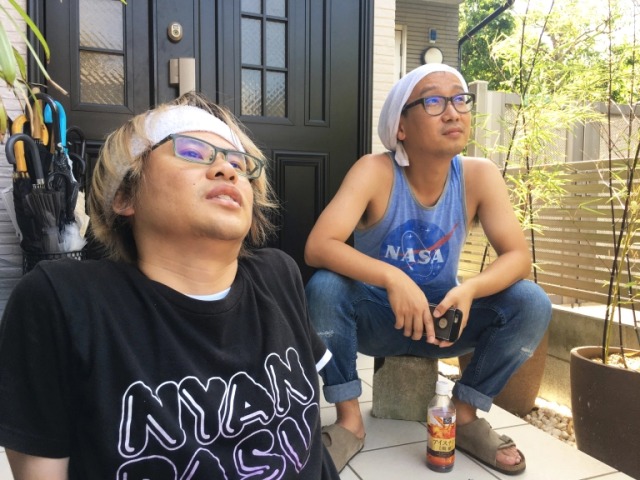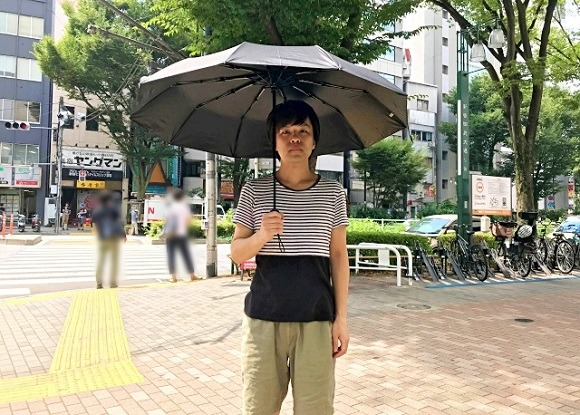
There are five seasons in Japan.
People who come to live in or visit Japan from other countries often have a humorous encounter with a Japanese person who informs them that “Japan has four seasons.” This often leaves the foreigner confused as to how to react to something that’s experienced in quite a few countries on Earth to some extent. It’s kind of like saying, “You know, in Japan we have both day and night!”
However, if someone were to casually bring up the fact that Japan has five seasons, I’d find myself suddenly more intrigued. And, for better or worse, that may soon be the case as a fifth season is gradually appearing in some settings.
Clothing companies are among the businesses most sensitive to seasonal changes and thus among the first to consider adopting widespread use of a five-season system. This fifth season is generally being called “Intense Heat” (“Mosho“). I imagine that’s a working title, but looking out the window, I’ll be damned if I can come up with a more appropriate name.
Traditionally, in the apparel industry, the four seasons are designated three calendar months each, with “Summer” being given July, August, and September. However, recently temperatures we tend to associate with summer are occurring before and after this period, so some companies have begun calling May, June, and July “Early Summer / Mid-Summer” while August and September are the “Intense Heat” months.
▼ Intense Heat is THE season for parasol fashion.
One such company, Sanyo Shokai, is currently operating in its first Intense Heat season. They made the switch after finding that last year, their sales of cooler-temperature Autumn fashions during August and September fell short of expectations.
Some Japanese readers of the news are already practicing telling people from other lands how many seasons there are in their country, while others feel five seasons is way too generous.
“There are five seasons in Japan.”
“Japan is the only country with five seasons.”
“I think a more accurate system is spring, summer, scorching, humid, fall, and winter.”
“The other day it was 35 degrees [Celsius] at 8 p.m. and it’s September…”
“A boutique near my station is already in fall mode, but I can’t even look at long sleeves.”
“I always have to go from shorts to winter clothing in about a day.”
“I can’t accept this. Vivaldi taught us that there are only four seasons.”
“I notice some companies are also turning the days of the week into Monday, Monday, Tuesday, Wednesday, Thursday, Friday, and Friday.”
“It’s really more like two seasons than four or five. Autumn’s only like four days long.”
I’m inclined to agree with that last comment, and in fact, rather than a five-season system, there are also some companies choosing to adopt a two-season release schedule of Winter and Summer. It sadly makes a lot of sense since I have a few thin, long-sleeve shirts in my closet that I’ve never used once because the periods when they could be worn seem to just fly by.
Another option would be to go way back to the old Chinese system of 24 seasons. It would probably be great for the fashion industry as we eagerly await what color is hot for keichitsu and if flared bottoms will make a comeback this kanro.
Source: Twitter/@nikkei_kotoba, TBS News Dig, Hachima Kiko
Photos ©SoraNews24
● Want to hear about SoraNews24’s latest articles as soon as they’re published? Follow us on Facebook and Twitter!


 W.T.F. Japan: Top 5 odd ways Japanese people beat the summer heat【Weird Top Five】
W.T.F. Japan: Top 5 odd ways Japanese people beat the summer heat【Weird Top Five】 Japan Meteorological Agency suspects rainy season may end earlier than ever this year
Japan Meteorological Agency suspects rainy season may end earlier than ever this year Summer in Japan doesn’t feel like a Japanese summer this year, many are saying
Summer in Japan doesn’t feel like a Japanese summer this year, many are saying Japanese lingerie company creates “Fest-Bras” to be worn outside during summer festival season
Japanese lingerie company creates “Fest-Bras” to be worn outside during summer festival season Japanese Twitter artist shares beautiful trick to draw anime-style clouds specific to the seasons
Japanese Twitter artist shares beautiful trick to draw anime-style clouds specific to the seasons Japanese beef bowl chain Sukiya’s 2026 Smile Box lucky bag basically pays for itself
Japanese beef bowl chain Sukiya’s 2026 Smile Box lucky bag basically pays for itself We revisited Sweets Paradise after a decade to see if Japan’s dessert buffet still delivers
We revisited Sweets Paradise after a decade to see if Japan’s dessert buffet still delivers Survey finds more than 70 percent of Japanese children have an online friend
Survey finds more than 70 percent of Japanese children have an online friend What’s it really like to climb Mt Fuji?
What’s it really like to climb Mt Fuji? 7-Eleven Japan’s ramen-cooking robot whipped us up a bowl of noodles【Taste test】
7-Eleven Japan’s ramen-cooking robot whipped us up a bowl of noodles【Taste test】 What’s the best way to spend 1,000 yen at the Seria 100-yen chainstore in Japan?
What’s the best way to spend 1,000 yen at the Seria 100-yen chainstore in Japan? Burgers soaked in a plate of hot cheese served at American Diner Andra in Tokyo
Burgers soaked in a plate of hot cheese served at American Diner Andra in Tokyo Shake Udon one-hand takeout bukkake noodle cups look to shake udon eating in Japan【Taste test】
Shake Udon one-hand takeout bukkake noodle cups look to shake udon eating in Japan【Taste test】 Cup Noodle tries an authentic Jiro-style ramen, but something’s not quite right
Cup Noodle tries an authentic Jiro-style ramen, but something’s not quite right We take a ride on Seibu Railway’s futuristic luxury liner: the Limited Express Laview
We take a ride on Seibu Railway’s futuristic luxury liner: the Limited Express Laview Starbucks Japan ready to get Year of the Horse started with adorable drinkware and plushies【Pics】
Starbucks Japan ready to get Year of the Horse started with adorable drinkware and plushies【Pics】 Hayao Miyazaki says Happy New Year to Studio Ghibli fans with new art for Year of the Horse
Hayao Miyazaki says Happy New Year to Studio Ghibli fans with new art for Year of the Horse 7 great places to see Mt. Fuji from without having to climb it
7 great places to see Mt. Fuji from without having to climb it We found possibly the quietest Japanese-style hotel in Tokyo’s bustling Shinjuku district
We found possibly the quietest Japanese-style hotel in Tokyo’s bustling Shinjuku district Hello Kitty Choco Egg figures are an adorable trip through three periods of Japanese pop culture【Pics】
Hello Kitty Choco Egg figures are an adorable trip through three periods of Japanese pop culture【Pics】 Japan’s oldest largetooth sawfish in captivity back on display in Mie Prefecture
Japan’s oldest largetooth sawfish in captivity back on display in Mie Prefecture Cyberpunk anime meets traditional culture in Ghost in the Shell gold leaf Japanese changing screens
Cyberpunk anime meets traditional culture in Ghost in the Shell gold leaf Japanese changing screens The best Starbucks Japan Frappuccinos we want to drink again in 2026
The best Starbucks Japan Frappuccinos we want to drink again in 2026 7-Eleven Japan starts new temporary luggage storage service in over 300 branches
7-Eleven Japan starts new temporary luggage storage service in over 300 branches Disillusionment at Tsukiji’s tourist-target prices led us to a great ramen restaurant in Tokyo
Disillusionment at Tsukiji’s tourist-target prices led us to a great ramen restaurant in Tokyo Starbucks teams up with 166-year-old Kyoto doll maker for Year of the Horse decorations【Photos】
Starbucks teams up with 166-year-old Kyoto doll maker for Year of the Horse decorations【Photos】 Tokyo considering law requiring more trash cans following litter increase in heavily touristed area
Tokyo considering law requiring more trash cans following litter increase in heavily touristed area Tokyo’s Tsukiji sushi neighborhood asks tour groups to stay away for the rest of the month
Tokyo’s Tsukiji sushi neighborhood asks tour groups to stay away for the rest of the month Tokyo event lets you travel back in time, for free, to celebrate 100 years since Showa era start
Tokyo event lets you travel back in time, for free, to celebrate 100 years since Showa era start Sanrio theme park in Japan announces plans to expand into a Sanrio resort
Sanrio theme park in Japan announces plans to expand into a Sanrio resort Japan may add Japanese language proficiency, lifestyle classes to permanent foreign resident requirements
Japan may add Japanese language proficiency, lifestyle classes to permanent foreign resident requirements Stamina-destroying “Paralysis Noodles” are Tokyo’s newest over-the-top ramen innovation
Stamina-destroying “Paralysis Noodles” are Tokyo’s newest over-the-top ramen innovation Survey asks foreign tourists what bothered them in Japan, more than half gave same answer
Survey asks foreign tourists what bothered them in Japan, more than half gave same answer Japan’s human washing machines will go on sale to general public, demos to be held in Tokyo
Japan’s human washing machines will go on sale to general public, demos to be held in Tokyo Japan’s deadliest food claims more victims, but why do people keep eating it for New Year’s?
Japan’s deadliest food claims more victims, but why do people keep eating it for New Year’s? We deeply regret going into this tunnel on our walk in the mountains of Japan
We deeply regret going into this tunnel on our walk in the mountains of Japan Studio Ghibli releases Kodama forest spirits from Princess Mononoke to light up your home
Studio Ghibli releases Kodama forest spirits from Princess Mononoke to light up your home Major Japanese hotel chain says reservations via overseas booking sites may not be valid
Major Japanese hotel chain says reservations via overseas booking sites may not be valid Put sesame oil in your coffee? Japanese maker says it’s the best way to start your day【Taste test】
Put sesame oil in your coffee? Japanese maker says it’s the best way to start your day【Taste test】 No more using real katana for tourism activities, Japan’s National Police Agency says
No more using real katana for tourism activities, Japan’s National Police Agency says Starbucks Japan reveals new sakura drinkware collection, inspired by evening cherry blossoms
Starbucks Japan reveals new sakura drinkware collection, inspired by evening cherry blossoms Updated cherry blossom forecast shows extra-long sakura season for Japan this year
Updated cherry blossom forecast shows extra-long sakura season for Japan this year New heated clothes hanger will dry your clothes in any type of weather
New heated clothes hanger will dry your clothes in any type of weather Cherry blossoms appearing early in Nagano… about half a year early
Cherry blossoms appearing early in Nagano… about half a year early Bra shirt for men: Japan develops new type of clothing to conceal men’s nipples
Bra shirt for men: Japan develops new type of clothing to conceal men’s nipples W.T.F. Japan: Top 5 Japanese autumn foods 【Well-Fed Top Five】
W.T.F. Japan: Top 5 Japanese autumn foods 【Well-Fed Top Five】
Leave a Reply